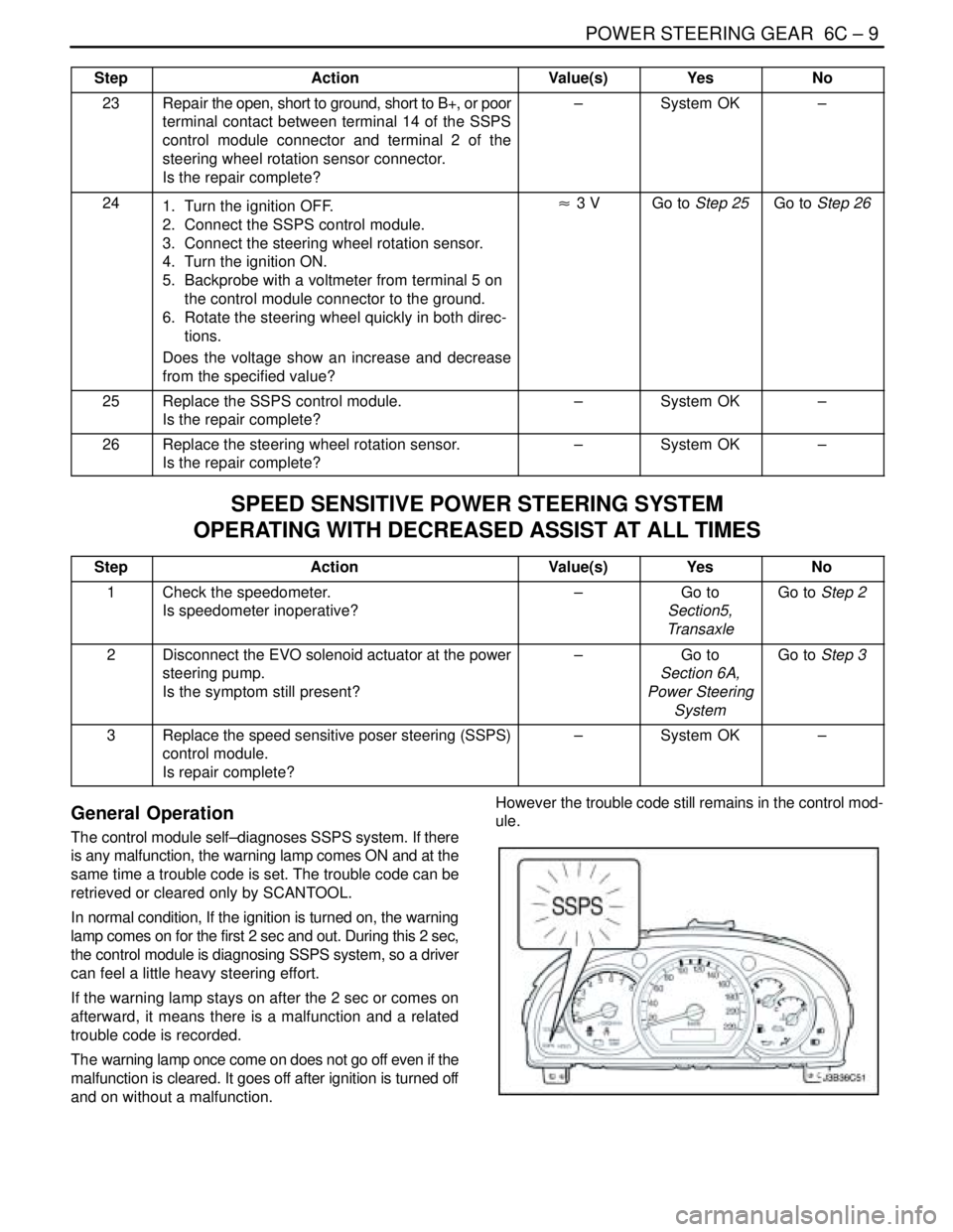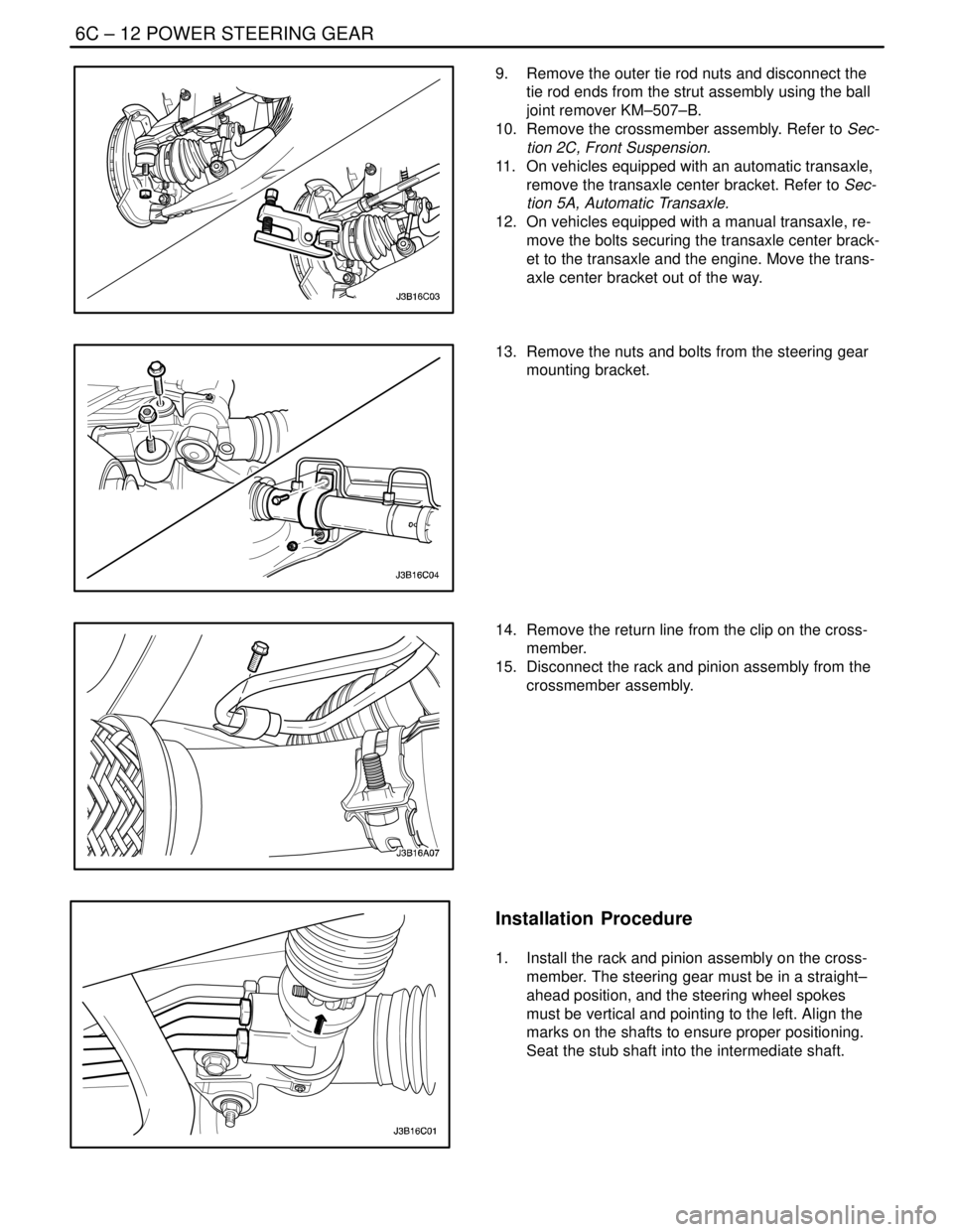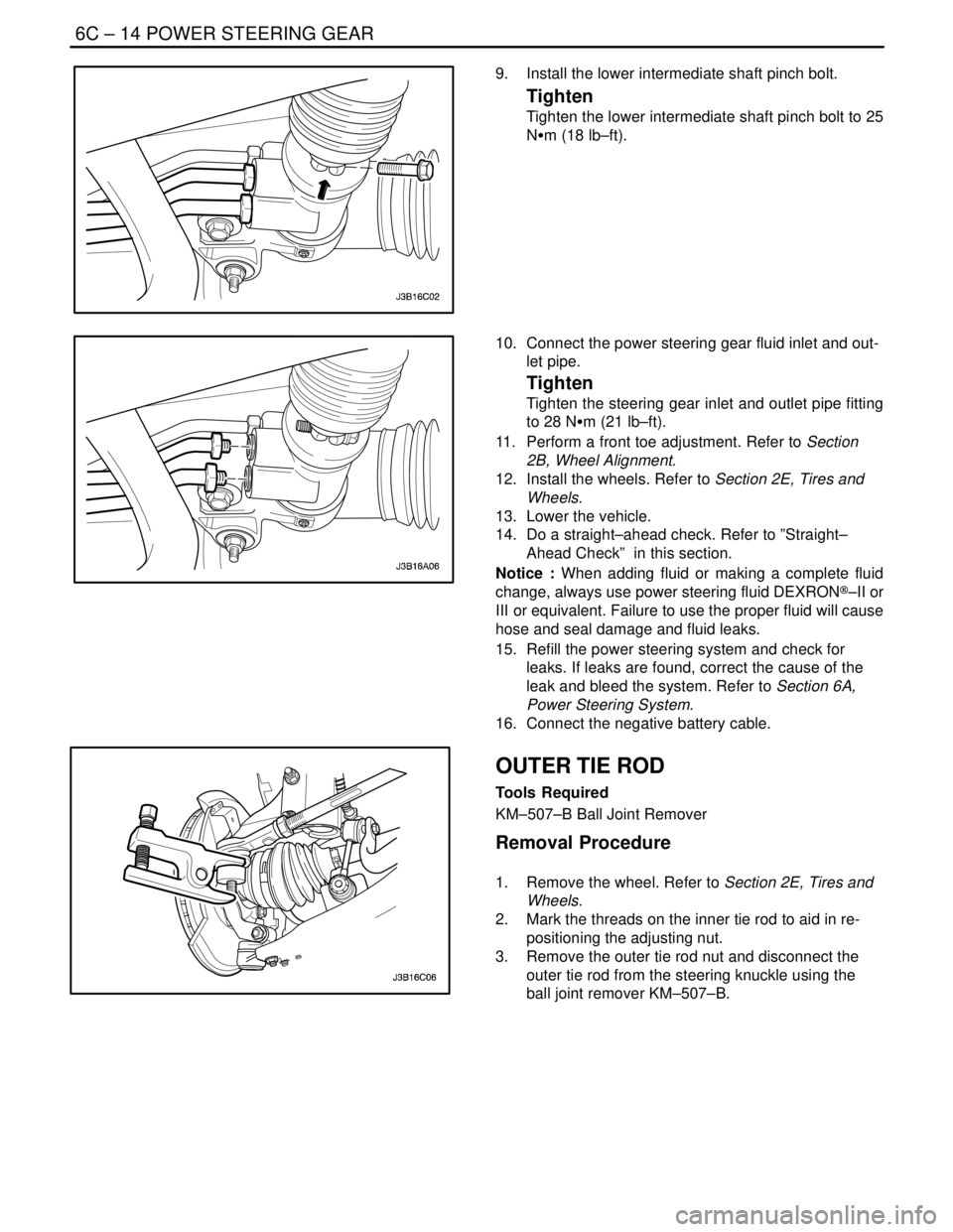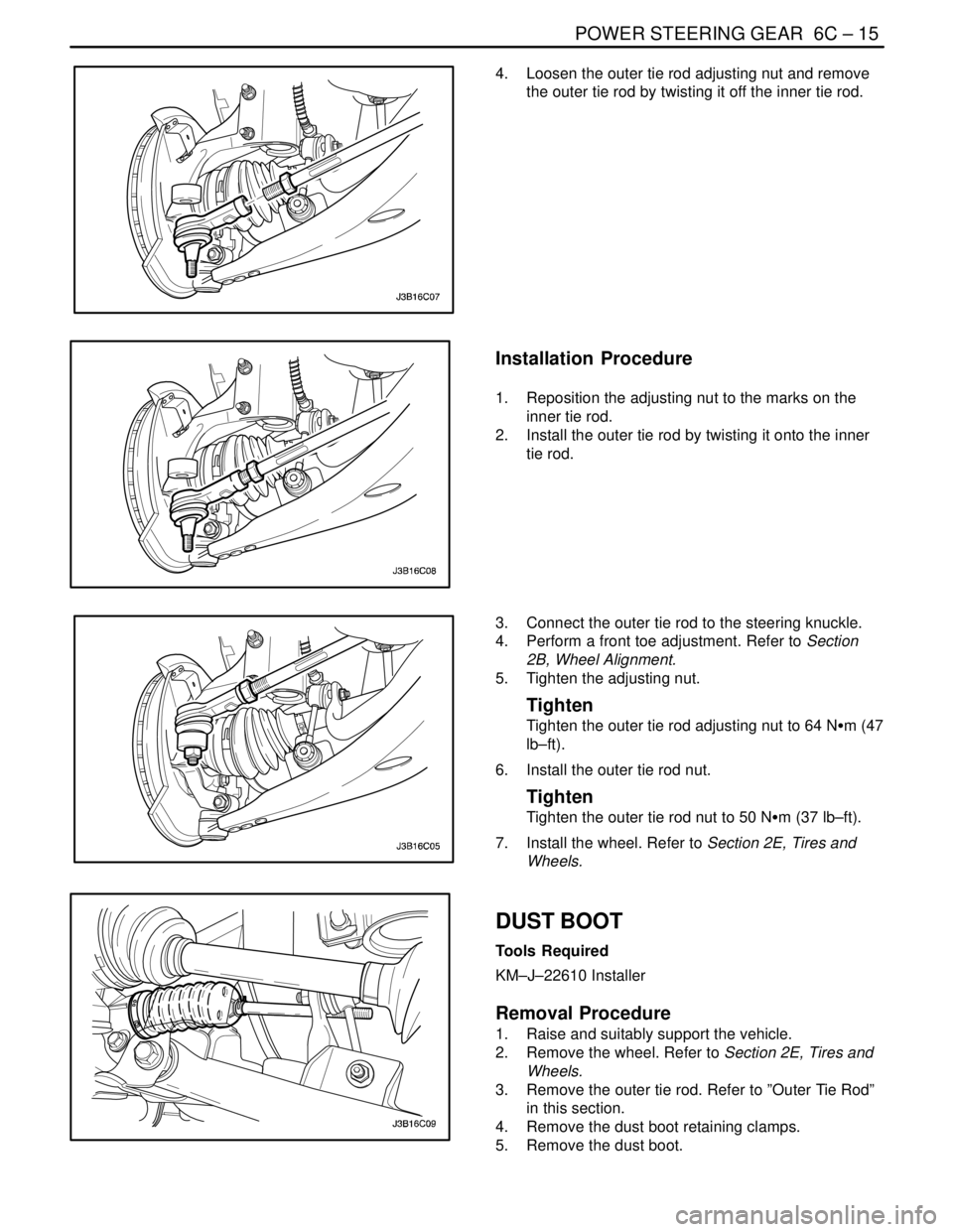Page 1926 of 2643

POWER STEERING GEAR 6C – 9
DAEWOO V–121 BL4
StepNo Yes Value(s) Action
23Repair the open, short to ground, short to B+, or poor
terminal contact between terminal 14 of the SSPS
control module connector and terminal 2 of the
steering wheel rotation sensor connector.
Is the repair complete?–System OK–
241. Turn the ignition OFF.
2. Connect the SSPS control module.
3. Connect the steering wheel rotation sensor.
4. Turn the ignition ON.
5. Backprobe with a voltmeter from terminal 5 on
the control module connector to the ground.
6. Rotate the steering wheel quickly in both direc-
tions.
Does the voltage show an increase and decrease
from the specified value?� 3 VGo to Step 25Go to Step 26
25Replace the SSPS control module.
Is the repair complete?–System OK–
26Replace the steering wheel rotation sensor.
Is the repair complete?–System OK–
SPEED SENSITIVE POWER STEERING SYSTEM
OPERATING WITH DECREASED ASSIST AT ALL TIMES
StepActionValue(s)YesNo
1Check the speedometer.
Is speedometer inoperative?–Go to
Section5,
TransaxleGo to Step 2
2Disconnect the EVO solenoid actuator at the power
steering pump.
Is the symptom still present?–Go to
Section 6A,
Power Steering
SystemGo to Step 3
3Replace the speed sensitive poser steering (SSPS)
control module.
Is repair complete?–System OK–
General Operation
The control module self–diagnoses SSPS system. If there
is any malfunction, the warning lamp comes ON and at the
same time a trouble code is set. The trouble code can be
retrieved or cleared only by SCANTOOL.
In normal condition, If the ignition is turned on, the warning
lamp comes on for the first 2 sec and out. During this 2 sec,
the control module is diagnosing SSPS system, so a driver
can feel a little heavy steering effort.
If the warning lamp stays on after the 2 sec or comes on
afterward, it means there is a malfunction and a related
trouble code is recorded.
The warning lamp once come on does not go off even if the
malfunction is cleared. It goes off after ignition is turned off
and on without a malfunction.However the trouble code still remains in the control mod-
ule.
Page 1927 of 2643
6C – 10IPOWER STEERING GEAR
DAEWOO V–121 BL4
Trouble Code
DTCTroubleDefault Action
01Actuator circuit open
02Actuator HI to LO short
03Actuator circuit short to B+
04Actuator HI short to GroundWarning lamp ON, Actuator Off
05Actuator LO short to Ground
06Steering Wheel Speed Sensor Open
07Steering Wheel Speed Sensor short to 5V
08Battey Voltage Out of Range (9~16 V)
Page 1928 of 2643
POWER STEERING GEAR 6C – 11
DAEWOO V–121 BL4
MAINTENANCE AND REPAIR
ON–VEHICLE SERVICE
RACK AND PINION ASSEMBLY
(Left–Hand Drive Shown, Right–Hand Drive
Similar)
Tools Required
KM–507–B Ball Joint Remover
Removal Procedure
1. Disconnect the negative battery cable.
2. Raise and suitably support the vehicle.
3. Remove the wheels. Refer to Section 2E, Tires and
Wheels.
4. Disconnect the power steering gear fluid outlet
pipe. Place a drain pan under the steering gear to
catch the power steering fluid.
5. Disconnect the power steering gear fluid inlet pipe.
6. Position the steering gear straight ahead by turning
the steering wheel until the steering wheel spokes
are vertical and pointed to the left.
7. Scribe a mark on the stub shaft housing that lines
up with a mark on the intermediate shaft lower cou-
pling.
8. Remove the intermediate shaft pinch bolt.
Page 1929 of 2643

6C – 12IPOWER STEERING GEAR
DAEWOO V–121 BL4
9. Remove the outer tie rod nuts and disconnect the
tie rod ends from the strut assembly using the ball
joint remover KM–507–B.
10. Remove the crossmember assembly. Refer to Sec-
tion 2C, Front Suspension.
11. On vehicles equipped with an automatic transaxle,
remove the transaxle center bracket. Refer to Sec-
tion 5A, Automatic Transaxle.
12. On vehicles equipped with a manual transaxle, re-
move the bolts securing the transaxle center brack-
et to the transaxle and the engine. Move the trans-
axle center bracket out of the way.
13. Remove the nuts and bolts from the steering gear
mounting bracket.
14. Remove the return line from the clip on the cross-
member.
15. Disconnect the rack and pinion assembly from the
crossmember assembly.
Installation Procedure
1. Install the rack and pinion assembly on the cross-
member. The steering gear must be in a straight–
ahead position, and the steering wheel spokes
must be vertical and pointing to the left. Align the
marks on the shafts to ensure proper positioning.
Seat the stub shaft into the intermediate shaft.
Page 1930 of 2643
POWER STEERING GEAR 6C – 13
DAEWOO V–121 BL4
2. Install the bolts and nuts on the steering gear
mounting bracket.
Tighten
Tighten the steering gear mounting bracket bolts and
nuts to 60 NSm (44 lb–ft).
3. Install the return line into the clip on the crossmem-
ber.
Tighten
Tightem the return line clip bolt to 8 NSm (71 lb–in).
4. On vehicles equipped with a manual transaxle,
position the transaxle center bracket in place and
install the bolts securing the bracket to the engine
and the transaxle.
Tighten
Tighten the transaxle center bracket–to–transaxle
bolts and the transaxle center bracket–to–engine bolt
to 80 NSm (59 lb–ft).
5. On vehicles equipped with an automatic transaxle,
install the transaxle center bracket. Refer to Section
5A, Automatic Transaxle.
6. Install the crossmember. Refer to Section 2C, Front
Suspension.
7. Connect the tie rod ends to the strut assembly.
8. Install the outer tie rod nuts.
Tighten
Tighten the outer tie rod nuts to 50 NSm (37 lb–ft).
Page 1931 of 2643

6C – 14IPOWER STEERING GEAR
DAEWOO V–121 BL4
9. Install the lower intermediate shaft pinch bolt.
Tighten
Tighten the lower intermediate shaft pinch bolt to 25
NSm (18 lb–ft).
10. Connect the power steering gear fluid inlet and out-
let pipe.
Tighten
Tighten the steering gear inlet and outlet pipe fitting
to 28 NSm (21 lb–ft).
11. Perform a front toe adjustment. Refer to Section
2B, Wheel Alignment.
12. Install the wheels. Refer to Section 2E, Tires and
Wheels.
13. Lower the vehicle.
14. Do a straight–ahead check. Refer to ”Straight–
Ahead Check” in this section.
Notice : When adding fluid or making a complete fluid
change, always use power steering fluid DEXRON®–II or
III or equivalent. Failure to use the proper fluid will cause
hose and seal damage and fluid leaks.
15. Refill the power steering system and check for
leaks. If leaks are found, correct the cause of the
leak and bleed the system. Refer to Section 6A,
Power Steering System.
16. Connect the negative battery cable.
OUTER TIE ROD
Tools Required
KM–507–B Ball Joint Remover
Removal Procedure
1. Remove the wheel. Refer to Section 2E, Tires and
Wheels.
2. Mark the threads on the inner tie rod to aid in re-
positioning the adjusting nut.
3. Remove the outer tie rod nut and disconnect the
outer tie rod from the steering knuckle using the
ball joint remover KM–507–B.
Page 1932 of 2643

POWER STEERING GEAR 6C – 15
DAEWOO V–121 BL4
4. Loosen the outer tie rod adjusting nut and remove
the outer tie rod by twisting it off the inner tie rod.
Installation Procedure
1. Reposition the adjusting nut to the marks on the
inner tie rod.
2. Install the outer tie rod by twisting it onto the inner
tie rod.
3. Connect the outer tie rod to the steering knuckle.
4. Perform a front toe adjustment. Refer to Section
2B, Wheel Alignment.
5. Tighten the adjusting nut.
Tighten
Tighten the outer tie rod adjusting nut to 64 NSm (47
lb–ft).
6. Install the outer tie rod nut.
Tighten
Tighten the outer tie rod nut to 50 NSm (37 lb–ft).
7. Install the wheel. Refer to Section 2E, Tires and
Wheels.
DUST BOOT
Tools Required
KM–J–22610 Installer
Removal Procedure
1. Raise and suitably support the vehicle.
2. Remove the wheel. Refer to Section 2E, Tires and
Wheels.
3. Remove the outer tie rod. Refer to ”Outer Tie Rod”
in this section.
4. Remove the dust boot retaining clamps.
5. Remove the dust boot.
Page 1933 of 2643
6C – 16IPOWER STEERING GEAR
DAEWOO V–121 BL4
Installation Procedure
1. Install the dust boot.
2. Install the tie rod end dust boot retaining clamp.
Install the cylinder end dust boot retaining clamp
with the installer KM–J–22610.
3. Install the outer tie rod. Refer to ”Outer Tie Rod” in
this section.
4. Install the wheel. Refer to Section 2E, Tires and
Wheels.
5. Lower the vehicle.
STRAIGHT–AHEAD CHECK
After all the necessary operations on the steering gear are
completed (removing and installing, disassembling and
assembling), check the exact straight–ahead position of
the steering in each case.
With the vehicle on the floor, place the steering wheel in
the straight–ahead position. Mark the centerline of both
tires on the floor. Turn the steering wheel all the way to the
right and mark the new centerline of both tires on the floor.